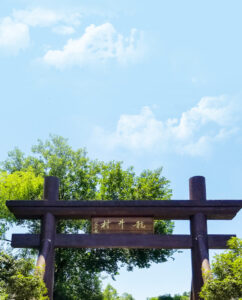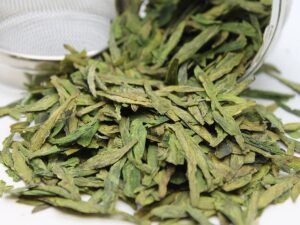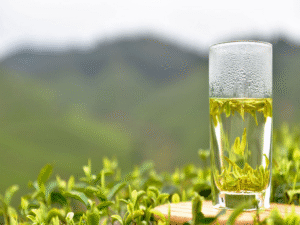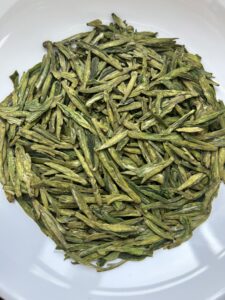Longjing tea, sometimes called by its literal translated name Dragon Well tea, is a variety of pan-roasted green tea from the area of Longjing Village in Hangzhou, Zhejiang Province, China. It is produced mostly by hand and renowned for its high quality, earning it the China Famous Tea title.As is the case with other green teas (and white teas), Longjing tea leaves experience minimal oxidation. When steeped, the tea produces a yellow-green color. The tea contains vitamin C, amino acids, and, like most finer Chinese green teas, has one of the highest concentrations of catechins among teas.


Production:
Like most other Chinese green tea, Longjing tea leaves are roasted early in processing (after picking) to stop the natural oxidation process. The actions of these enzymes are stopped by “firing” (heating in pans) or by steaming the leaves before they completely dry out. As is the case with other green teas (and white teas), Longjing tea leaves experience minimal oxidation. When steeped, the tea produces a yellow-green color. The tea contains vitamin C, amino acids, and, like most finer Chinese green teas, has one of the highest concentrations of catechins among teas.
Legends:
Longjing tea was granted the status of Gong Cha, or imperial tea, in the Qing dynasty by the Kangxi Emperor. According to the legend,[3] the Kangxi Emperor’s grandson, the Qianlong Emperor, visited West Lake during one of his famous holidays.
He went to the Hu Gong Temple under the Lion Peak Mountain (Shi Feng Shan) and was presented with a cup of Longjing tea. In front of the Hu Gong Temple were 18 tea bushes. The Qianlong Emperor was so impressed by the Longjing tea produced here that he conferred these 18 tea bushes special imperial status. The trees are still living and the tea they produce is auctioned annually for higher price per gram than gold. There is another legend connecting the Qianlong Emperor to Longjing tea. It is said that while visiting the temple he was watching the ladies picking the tea. He was so enamored with their movements that he decided to try it himself. While picking tea he received a message that his mother, Empress Dowager Chongqing, was ill and wished his immediate return to Beijing. He shoved the leaves he had picked into his sleeve and immediately left for Beijing. Upon his return he immediately went to visit his mother. She noticed the smell of the leaves coming from his sleeves and he immediately had it brewed for her. It is said that the shape of Longjing Tea was designed to mimic the appearance of the flattened leaves that the emperor brewed for his mother.
ongjing, which literally translates as “dragon well,” is said to have named after a well that contains relatively dense water, and after rain the lighter rainwater floating on its surface sometimes exhibits a sinuous and twisting boundary with the well water, which is supposed to resemble the movement of a Chinese dragon.
Recommend Brewing Method
Teacup: 250ml
185℉/85℃
2 Teaspoons / 2.5g Tea
Brewing Time:2-5mins
Put some tea in a cup and then a small amount
of hot water, just immersing the tea.When the
tea leaves stretch, add water to 7/10 cups.
You can also put a small amount of water into the
cup first, and then tea, and finally pour more water
to a 7/10 cup.
Storage: Keep refrigerated, store in airtight, opaque packaging.





